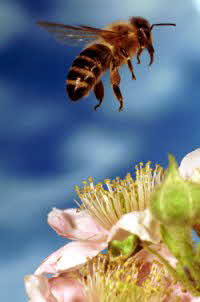See also: Bee Trivia; Honey Intoxication
HONEY & HONEYBEES TRIVIA
In 2011 the U.S. supply of movable honeybee hives is a little more than 2 million hives. That is only half of the number of movable hives available in the mid 1940s, yet the total acreage of plants needing pollination has almost doubled in the same time. (Science News: April 9, 2011)

In 2009 The U.S. per capita consumption of honey was around 1.1 pounds per year.
An apiary dating from the 10th century BC has been discovered in northern Israel. (2009)
About 1/3 of all honeybee colonies in the U.S. perished during 2007 due to several deadly viruses (collectively called Colony Collapse Disorder). Little is understood about the reasons this problem has become so severe.
In ancient Egypt, citizens paid their taxes with honey.
There are 211,600 beekeepers and 2.63 million colonies of honeybees, which produce more than 220 million pounds of honey each year in the United States.
A single hive of honeybees may contain as many as 80,000 bees.
Honey bees have four wings.
Honey was most likely the first sweet 'treat' that humans discovered.
It takes about 2 million flower visits by honeybees to produce 1 pound of honey.
* The Honeybee (Apis mallifera) was designated as the Official Insect of Vermont, Louisiana and Wisconsin in 1977.
* In 2006 Kentucky recognized the Clarkson Honeyfest as its official State Honey Festival.
* Kentucky's official agricultural insect was designated as the honey bee in 2010.
* The honey bee was designated the official state insect of Missouri on July 3, 1985.
* The honeybee, is the New Jersey state Bug.
* South Dakota adopted the honey bee as the state insect in 1978.
* The honeybee is the official state insect of Maine.
* Mississippi designated the Honeybee as its Official State Insect in 1980.
* In 1975 the Honeybee was designated as the Official State Insect of Nebraska.
* The Honeybee was designated as the Official Insect of West Virginia in 2002.
* The Honeybee was designated as the Official Agricultural Insect of Tennessee in 1990.
* The Honeybee was designated as the Official Insect of North Carolina in 1973.
* The Honeybee was designated as the Official Insect of Oklahoma in 1992.
* Utah is known as the beehive state.
The popular and varied uses of honey as a medicine in ancient Egypt can be seen in Egyptian medical texts dating back to about 2,500 B.C. In these texts, honey is listed in hundreds of remedies.
Since honey has the ability to absorb and retain moisture, it is used in the baking industry to keep baked goods fresh and moist.
Honey contains 18 more calories per tablespoon than refined sugar.
Never give honey to infants under 1 year old, as honey may contain Clostridium botulinum spores to which infants have very little resistance. Once ingested, these spores may germinate and release deadly toxins. Once infants are a year or so old, they have developed some resistance to botulinum spores.
In the 16th century, Conquering Spaniards found that the natives of Mexico and Central America had already developed beekeeping. A distinct family of stingless bees (not true honey bees) was native to these regions.
European settlers introduced European honey bees to New England in about 1638. North American natives called these honey bees the "white man's flies." Honey was used to prepare food and beverages, to make cement, to preserve fruits, to concoct furniture paste-polish and varnish and for medicinal purposes.
Since 1980, U.S. honey production has averaged around 200 million pounds per year. In 2003, over 181 million pounds of honey were produced in the United States. The average annual yield per colony was 69.9 pounds of honey. The average producer price per pound was $1.40. The 2003 honey crop was valued at over $255 million.
National Honey Board www.honey.com
The U.S. per capita consumption of honey was around 1.31 pounds per year in 2004.
The U.S. Department of Agriculture has estimated that there are between 139,600 and 212,000 beekeepers in the United States (2003). The vast majority (95%) are hobbyists with less than 25 hives. In addition, about 4% are part-timers who keep from 25 to 299 hives. Together, hobbyists and part-timers account for about 50 percent of bee colonies and about 40 percent of honey produced. The number of U.S. bee colonies producing honey in 2003 was 2.59 million (based on beekeepers who manage five or more colonies).
FREE Magazines
and other Publications
An extensive selection of free magazines and other publications
Also see: Food Articles and Cooking Tips
FOOD TRIVIA and FOOD FACTS
Please feel free to link to any pages of FoodReference.com from your website.
For permission to use any of this content please E-mail: james@foodreference.com
All contents are copyright © 1990 - 2025 James T. Ehler and www.FoodReference.com unless otherwise noted.
All rights reserved. You may copy and use portions of this website for non-commercial, personal use only.
Any other use of these materials without prior written authorization is not very nice and violates the copyright.
Please take the time to request permission.
Popular Pages
CULINARY SCHOOLS
& COOKING CLASSES
From Amateur & Basic Cooking Classes to Professional Chef Training & Degrees
FoodReference.com (since 1999)
Home | Articles | FOOD TRIVIA | Today in Food History | Food_Timeline | Recipes | Cooking_Tips | Food Quotes | Who’s Who | Culinary Schools and Tours | Food_Trivia_Quizzes | Food Poems | Free Magazines | Food Festivals & Events
You are here > Home >
FOOD TRIVIA and FOOD FACTS SECTION
